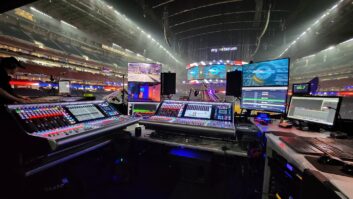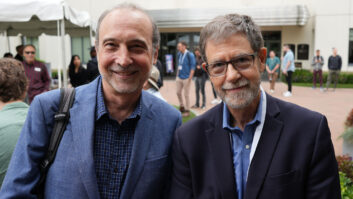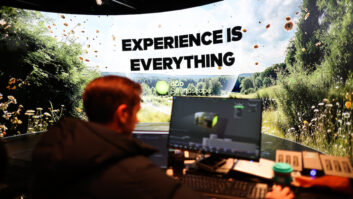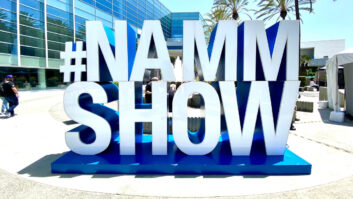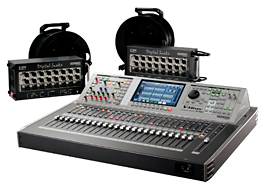

Two years ago, Roland first entered into the live sound market with the RSS Digital Snake. Since then, the company has been quietly developing a small-format digital console using some of the RSS’ technology. The Roland V-Mixer includes the M-400 desk, whose simple looks and small footprint belie the fact that much lies beneath the surface. The mixer communicates audio control via two Cat-5e cables to the remote S-1608 or S-3208 stage boxes, which comprise 16 or 32 phantom-powered mic or line inputs and eight outputs. The scalable and affordable system offers all the bells and whistles you’d expect from a digital board.
FROM THE TOP
The M-400 features 25 motorized, 100mm touch-sensitive faders and a large 800×480 TFT color screen with eight corresponding soft keys underneath for choosing various screen-driven options. I was impressed by the screen’s readability — even off-axis or in bright light. At 29×24×9 inches (W×D×H) and weighing 29 pounds, this is not a large console and is perfect for applications where space is a factor. The 24 faders are bankable in four layers: channels 1 to 24, channels 25 to 48, 16 auxes/eight DCAs and a user-definable layer. The desk’s fader module section offers what you’d expect: Apart from the fader, there’s mute and solo buttons, 7-position LED meter and a channel-select button that directs the channel’s settings to the screen. I liked the Touch-Select option, which sends the channel automatically to the screen simply by touching the fader. You can also set the fader’s sensitivity to adjust the amount of “touch” it takes to make the system jump to the selected channel.
The left side of the desk offers hardware control of the software processors and other channel strip functions. If you want to adjust the EQ, simply select a channel, hit the On button in the equalizer section and start tweaking. There are dedicated gain and frequency controls for the low and high bands, plus Q control for the two mid-bands. This type of master channel setup lets you control the software processors using one knob per function, plus you get a nice, bright readout of the parameters represented on the screen. You can zoom in on various sections by pushing the DISP button, which brings up a detailed pop-up of the that section.
To the right of the screen are various functions that you’d want at your fingertips, such as cursor navigation, talkback control, mute group recalls, scene memory record/recall and controls for the USB playback/recorder. Speaking of which, the recorder’s inputs can be assigned from the aux outs or main outs, with playback coming directly to two channels on the console. The recorder’s display gives you source control L and R, record level, two meters, time remaining and destination (your return channels). I found this function especially useful and the output sounded great. You can use it to record the show or play back tracks between acts — all on a simple USB stick.
Although the system maxes out at 48 inputs, it can be purchased in three ways. The Basic ($10,450) configuration comes with a single S-1608 stage box with 16 inputs and eight outputs; Standard ($11,995) comprises two S-1608s for 32-channel operation with 16 outs; and Expanded ($15,495) offers an S-1608 and an S-3208 for 48 total channels of remote input and 16 outs. These inputs can be split off as many times as you’d like (to monitorland, for instance) using a Gigabit router. Keep in mind that there are only 40 channels available digitally; if you want to bring a full 48 inputs back to front of house, you have to use the console’s analog inputs.
The V-Mixer’s software (PC only) allows you to configure the console offline or run it from a laptop via USB 2, even while someone else is using the console’s surface. You can record up to 40 tracks of audio using a Gigabit Ethernet port via Cat-5 to a computer directly into Cakewalk’s SONAR REAC software, which carries 40 channels of 96k/24-bit audio, plus MIDI and remote-control data. Remember that the V-Mixer maxes out at 48k/24-bit, but who knows what this portends for the future?
ABLE-BODIED PROCESSING
The system gives you four stereo effects engines (FX 1 to 4) that can be used as inserts on a channel or in the traditional sense, where you’d send signals from several channels to the effect via an aux send. There are 48 effects presets spanning 11 different effects types and 199 user-definable presets. The four effects can be linked as one stereo effect or split as two mono engines, giving you eight effects total. Within the engine is an inline channel strip effect that gives you an expander/gate/ducker, compressor, de-esser, enhancer, EQ A, EQ B (both are 4-band parametric EQs) and a delay. This can be inserted across the stereo bus and as a channel. In addition, there are four 31-band graphic EQs available (GEQ 1 to 4).
The reverbs, effects and delays sound great and are very musical. You can see where Roland’s years of experience in the desktop recording market has paid off. What surprised me most was how usable the EQ, gates and compressors were. Not that I’m jaded, but at this price range — in addition to my experience with the stock software processors in Roland’s VS Series recorders — I wasn’t expecting much. However, they sounded great. The compressor has nine different knee settings with adjustable ratio from 1:1 to infinite and auto-makeup gain. Although I liked the compressor’s responsiveness and sound, the auto-gain seemed to be counterintuitive in that the gain shot up sharply with auto-gain on, way above the level when the compressor was off. For the beginner, there are presets for the gates, EQ and compressors for various instruments, some of which made sense. You could use these presets as a start, but I wouldn’t rely on a preset by its name alone — your ear should be the ultimate arbiter of what works.
I tested the EQ on a kick drum with great results. I was lucky enough to hear the V-Mixer through an L-Acoustics KUDO line array system with four subs through Lab. Gruppen amps, so playback was impressive. I quickly turned on the EQ, grabbed 50 Hz and boosted the fundamental frequency, bringing out the kick drum’s thump. I could also eliminate some of the drum’s boxiness by ducking 400 Hz on the lo-mid band. Here, the Q control came in handy as I was able to keep adjacent info untouched while zeroing-in on just the frequencies that were keeping the drum from sounding great.
The gates worked very well with one small exception. I quickly set up the gate on a snare, adjusted the threshold and saw it all reacting on the screen. However, when I went to filter the hi-hat out of the feed to the gate by assigning the filter to the sidechain and rolling off the top end, I quickly realized that not only does the filter go to the sidechain, but so does the whole EQ, which renders the snare channel’s EQ useless. While you can use an unused EQ from another channel, I’d like to see the ability to split off the filter separately from each channel to its own gate while leaving the EQ independent and on the channel.

EASY TO GET AROUND
The M-400 is all about workflow, with some great options that make it easy to get things done quickly. I especially liked how easy it was to copy a channel’s settings to a single or a range of channels. By choosing Copy from the main channel display, I could choose which part of a channel’s settings to copy. Most settings can be copied, excluding the pad — another option I’d like to have.
The Sends-On Fader button flips the aux levels to the fader, making it easy to jump through 16 mixes quickly when you’re using the M-400 for monitor applications. There are also eight dedicated hardware buttons that can be set to almost anything you’d like. You can assign the button to snap to a scene, mute group, oscillator screen, effect bypass or graphic EQ, meter-peak clear, change meter point, or channel-select Prev or Next. This feature makes it easy to get to those buried functions quickly with a dedicated button.
The Group button makes multichannel control a breeze by bringing up eight DCAs and letting you easily assign a channel or aux send to that fader. You can also name and color the DCAs so that they’ll show up onscreen with an instrument name and color.
However, there’s some room for improvement. For instance, Scene recall takes about two seconds, and while it doesn’t mute the audio, it isn’t as nimble as it needs to be. Creating a mute scene would be a workaround but wouldn’t involve anything but mutes.
STADIUM-READY
I tested the V-Mixer at the cavernous 63,400-seat University of Phoenix stadium in Glendale, Ariz., home of the NFL’s Arizona Cardinals. On Easter Sunday, Glendale’s Radiant Church rented the venue for its services, and the V-Mixer captained by engineer Keith Morris was at FOH. The input list was formidable and every possible input on the console was used, but the V-Mixer stood up to the task. There were 25 channels for the band and eight for the featured singers and choir. In addition, two opening acts were allotted a total of seven channels, and there was a mic for the pastor on one channel, another channel for video playback, two channels for walk-on music and two stereo effects inputs — a total of 48 inputs. All of these were routed to the appropriate channels via the V-Mixer’s digital patchbay, which allows you to set up, save and recall various console configurations. All digital and analog inputs were used. However, if your setup is larger, it’s possible to gang two units together, effectively doubling your I/O capacity.
The output setup in the venue was just as extensive as the input setup. There was a stereo digital out sent to a 2-channel recorder, one channel back to video and 40 channels were recorded to a PC using Cakewalk’s REAC recording software via Cat-5. The board’s stereo out was sent to six L-Acoustics V-DOSC loudspeakers facing front (left and right) — two auxes were linked, making a matrix that was sent to six V-DOSC arrays for left and L/L, and two more linked auxes created a matrix sending six outs to JBL VerTec 4088s L/L/L. The same setup was used for the right side, where six subs were used. The entire show went off without a hitch, and the V-Mixer easily jumped between setups.
A V-ANTASTIC SYSTEM
The V-Mixer had me doing a “reality check” over and over as I reviewed the product. This much usable functionality at this price is nothing short of astounding. I say “usable” because there is no fluff in the V-Mixer; the software gates, effects, compressors and EQs are musical and easy to use. In addition, the GUI is friendly, intuitive and gives you a lot of useful feedback as to what’s going on inside the box. The educational factor is important because this system is perfect for house of worship and A/V situations where users aren’t often audio pros and you have to get up-close and personal with the gear in a short amount of time. If you get stuck, the Help screen contains the entire manual, making it easy to query the “oracle” if you have a question. The manual is well written and takes nothing for granted. All of this is written in basic terms that any user could understand.
V-Mixer also provides a user-definable system lock for keeping some or all console settings out of the reach of unauthorized users. The system also carries some nice unexpected extras. The REAC multichannel recording and USB recorder/playback features add value, as does V-Link, which integrates the system with other Roland and Edirol gear. I saw V-Link in action at NAB 2008, where an Edirol video mixer controlled the V-Mixer’s audio. As you crossfaded from one video feed to another on the Edirol, the audio faders on the V-Mixer that carried the corresponding audio would fade up or down — simple but slick.
All this for just around $10k is quite something and well worth a look if you’re on a budget yet thinking of stepping up to a pro-quality digital live system.
Roland Systems Group, 800/380-2580, www.rolandsystemsgroup.com.
Kevin Becka is Mix’s technical editor.

WATCH: Must Play
Exclusive Video

